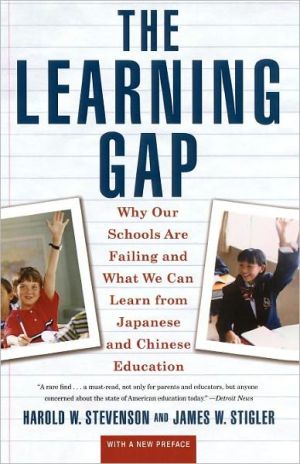The Learning Gap
It is no secret that American education is in crisis. Our children lag behind students in other countries--and they are losing ground. In The Learning Gap, Harold W. Stevenson and James W. Stigler put this crisis in perspective by comparing teachers, parents, children, schools, and educational practices in the United States, Japan, Taiwan, and China. Based on five major studies, funded by the National Institutes of Health and the National Science Foundation and featured on the front page of...
Search in google:
It is no secret that American education is in crisis. Our children lag behind students in other countries--and they are losing ground. In The Learning Gap, Harold W. Stevenson and James W. Stigler put this crisis in perspective by comparing teachers, parents, children, schools, and educational practices in the United States, Japan, Taiwan, and China. Based on five major studies, funded by the National Institutes of Health and the National Science Foundation and featured on the front page of The New York Times, this is the first comprehensive account of what works in elementary education and what doesn't--and why. The authors analyze the role of standardized tests, tracking, special education, class size, money, classroom discipline, textbooks, and parental involvement and arrive at some startling conclusions that will drastically alter our understanding of the problems and possibilities of our schools. Television is not to blame for children's poor performance nor are underpaid or poorly trained teachers. And contrary to prevailing opinion, class size should be increased, and children should not begin academic preparation in preschool and kindergarten. Most important, the authors show that parental involvement is critical to children's learning and that schools should reward individual effort rather than emphasize innate ability. Bringing a clarity of purpose to the debate on education that is missing from the schools themselves, The Learning Gap is a landmark study that will shape the educational agenda of the future. Library Journal Stevenson (psychology, Univ. of Michigan) and Stigler (psychology, Univ. of California, Los Angeles) offer a comparison between American (Chicago, Minneapolis) and Asian (Taiwan, China, Japan) elementary schools. Quantifiable variables include instruction time, test data, length of school year, curriculum studied, and instruction strategies. Another factor the authors consider is attitude (e.g., parental attitudes toward schooling, children toward learning, society toward educators, etc.). The writing style is informal, and sufficient statistical data is presented to support the findings. Some challenges are offered: ``The American educational system as it currently exists is producing an educationally advantaged minority and a disadvantaged majority.'' The authors conclude that ``Americans are proud of their individualism; Asians are proud of their group orientation.'' For large public and academic libraries.-- Lois F. Roets, Drake Univ., Des Moines
Preface71Introduction132Academic Achievement283Children's Lives524Socialization and Achievement725Effort and Ability946Satisfactions and Expectations1137The Organization of Schooling1308The Profession of Teaching1569The Practice of Teaching17410Defining the Solution200Endnotes225For Further Reading233
\ Library JournalStevenson (psychology, Univ. of Michigan) and Stigler (psychology, Univ. of California, Los Angeles) offer a comparison between American (Chicago, Minneapolis) and Asian (Taiwan, China, Japan) elementary schools. Quantifiable variables include instruction time, test data, length of school year, curriculum studied, and instruction strategies. Another factor the authors consider is attitude (e.g., parental attitudes toward schooling, children toward learning, society toward educators, etc.). The writing style is informal, and sufficient statistical data is presented to support the findings. Some challenges are offered: ``The American educational system as it currently exists is producing an educationally advantaged minority and a disadvantaged majority.'' The authors conclude that ``Americans are proud of their individualism; Asians are proud of their group orientation.'' For large public and academic libraries.-- Lois F. Roets, Drake Univ., Des Moines\ \








